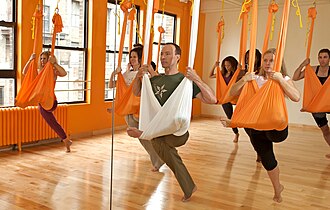Aerial yoga

Aerial yoga is a hybrid type of yoga developed by Michelle Dortignac in 2006 combining traditional yoga poses, pilates, and dance with the use of a hammock.[1]
History
[edit]Aerial yoga was developed by Michelle Dortignac in 2006, using a combination of traditional yoga poses, pilates, and dance with the use of a hammock.[1] Fly Yoga was developed in France in 2009 by Florie Ravinet in collaboration with a physical therapist, and has been "approved by health professionals".[2][3] AeroYoga was developed around the same time by Rafael Martinez.[4]
Hammock
[edit]Aerial yoga requires a special kind of hammock, a prop designed to support up to 300 kilograms on average. The rig typically consists of support chains, a webbing strap, a silk hammock and carabiners. Two support chains hang from the ceiling to less than one meter above ground level, and the hammock is connected at the height set by the user.[5] There are two styles of installing an aerial yoga hammock, depending on the effects desired: either two anchor points (for more stability) or one anchor point, to give the participant an increased range of motion.[6]
The hammock acts like a swing supporting the hips for forward bends and backbends. Difficult mat-based yoga postures may prove easier to perform through aerial yoga, while the hammock's movement further contributes to adding variety to the aerial workout.[7]
Health benefits claimed
[edit]Aerial yoga has not been studied with clinical trials. Anecdotal evidence indicates that by facilitating bending and stretching of the whole body during exercise, muscles and joints will be strengthened and rehabilitated, and the spine decompressed as the body hangs freely.[8] Yoga in general, and aerial yoga in particular is promoted as benefiting emotional, psychological and spiritual health.[9]
Popular poses
[edit]Aerial yoga poses include the cross position, leaning back with support just above the waist, arms outspread;[10] the star inversion, the hammock supporting the tailbone with the body bending backwards; and the one-legged king pigeon pose, like the star inversion but with one foot hooked across the front of the hammock. A bound variant has the rear ankle grasped by the hands.[1]
References
[edit]- ^ a b c Dortignac, Michelle (17 June 2015). "The Aerial Yoga Sequence: 9 Poses to Defy Gravity". Yoga Journal. Retrieved 4 June 2018.
- ^ "Du yoga dans l'air!" [Yoga in the air!]. www.psychologies.com (in French). 15 April 2013. Retrieved 6 July 2022.
- ^ "Florie Ravinet". Fly-Yoga.fr (in French). Retrieved 6 July 2022.
- ^ "Únete a la mayor compañía de yoga aéreo del mundo" [Join the world's largest aerial yoga company]. Aeroyoga-official.com (in Spanish). Retrieved 6 July 2022.
- ^ Macmillan, A. (2014). "Quick Tips: What is Antigravity Yoga?". howstuffworks. Retrieved 25 July 2020.
- ^ Harvey, Cat (20 July 2022). "How to Do Aerial Yoga at Home (Getting Started)". Yoga Answered. Retrieved 8 August 2022.
- ^ Singh, Ayesha (21 February 2015). "New Yoga Sutras". New Indian Express. Retrieved 25 July 2020.
- ^ McAuley, Alicia (2014). "The benefits of Aerial Yoga". Best Health Magazine. Reader's Digest Magazines. Retrieved 25 July 2020.
- ^ Watts, Anna (2014). "5 Interesting Benefits of Aerial Yoga". Your Daily Workout. Retrieved 25 July 2020.
- ^ Curtis, Carmen (23 July 2015). "8 Essential Aerial Yoga Poses You Have to Try". Wanderlust. Retrieved 4 June 2018.

